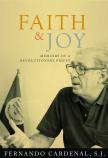Of and for the Poor
Those of us whose memories are long enough to recall the days of the Sandinista Revolution in Nicaragua know the names of Miguel D’Escoto, Ernesto Cardinal and Fernando Cardenal, for all sorts of reasons—especially for their appointments to positions in the Sandinista government and the less than enthusiastic response of Rome to the idea of ordained priests serving in a Marxist-socialist administration. Most people probably know least about Fernando, but this newly published memoir, shortened from the Spanish original published in 2009, should change all that.
A lifelong Jesuit who eventually committed himself to the anti-Somoza struggle of the 1970s, became director of the literacy crusade and later minister of education in the post-revolutionary government of the 1980s, he was eventually forced by John Paul II to leave the Society of Jesus. But he continued to live in the community and later became the first person to be readmitted to vows in the Jesuit order after having been dismissed. To this outline, Cardenal adds a great deal of color and pathos, with a dash of humor here and there.
Although the text of the memoir reaches back briefly to Cardenal’s time in training, or “formation,” as a Jesuit, and ends in 2004 with his pronouncing final vows in the order, the bulk of these recollections cover the years from 1970 to 1990. In 1970 Cardenal took up his first post as a priest, serving at the Jesuit University of Central America (U.C.A.) in Managua as vice president of student affairs. In 1990 the Sandinista government of Daniel Ortega surprisingly lost the election to a coalition of small parties led by Violetta Chamorro, precipitating corruption and power struggles among the Sandinistas that led Cardenal to resign from the party. He resigned for the same reason that he had joined the party more than 15 years earlier, his concern for the poor.
In my 35 years of teaching about liberation theology I have heard time and time again that it all begins in the experience of the poor and that, in the famous words of Gustavo Gutiérrez, “theology comes after,” it is the “second act.” That this is true I have no doubt, and consequently I have also learned that if you want to teach students about liberation theology, the volume upon volume of learned theological essays by all the great Latin American theologians pale in their usefulness beside one or two first-hand accounts. Best of all has been Mev Puleo’s set of interviews in Brazil during the 1980s, The Struggle Is One: Voices and Visions of Liberation. But Faith and Joy is a close second.
Faith and Joy is a first-person account of what revolutionary change in the church meant to the poor. It describes, often in great detail, many of the church-inspired movements in the Nicaraguan revolution. We encounter Nicaragua’s own version of the student movements that marked Europe in the late 1960s, as the students of U.C.A. demanded a greater say in their own education and occupied the university in time-honored fashion until their demands were heard. We learn how the Jesuit order in Central America shifted its orientation to the service of the poor. We get an eye-witness account of the terrible devastation of the earthquake that flattened Managua in 1972. And we are led through the heart-searching that Cardenal endured before he committed himself to the cause of the Sandinista Front for the liberation of Nicaragua.
Inevitably, the most interesting chapters are those that cover the years between Cardenal’s joining the Sandinista Front and the end of the Ortega administration in 1980. It may come as a surprise to some just how important Cardenal was in the five years before Somoza was overthrown, when he served as one of “the group of 12,” an influential team of individuals who mostly lived outside Nicaragua at this time. They were not officially representative of the Sandinista Front but worked to promote their cause in the surrounding Central American countries, most effectively in Costa Rica. No doubt it was Cardenal’s success that led to his being offered a post in the new government, though he was horrified to learn that they wanted him to be their ambassador to the United States. Fortunately for him, that was changed to the much more appropriate role of working with the youth.
The Nicaraguan bishops at the time were very conservative, even though in the end they spoke out against Somoza. (A friend once described them to me, in the days after the revolution had succeeded, as “little boys who have had their toys taken away.”) But they moved to invoke Canon 285 of the Code of Canon Law, which prohibits priests from holding political office. Despite the intervention of the Vatican secretary of state at the time, Cardinal Casaroli, Cardenal, along with his brother Ernesto and the Maryknoll priest Miguel D’Escoto, were suspended from priestly work and Cardenal was eventually dismissed from the Society, though the Jesuits obeyed the papal edict with heavy hearts and did all they could to mitigate the harm. Later, thankfully, he was reinstated.
This is a familiar story and remains a distressing one. What this book adds, in this episode as throughout the 15 chapters, is the first-hand witness of a holy man to his struggle to be faithful to the Gospel’s call to care for the poor. Faith and Joy is a good title for the book. But maybe Courage and Compassion would have been even better.
This article also appeared in print, under the headline “Of and for the Poor,” in the January 18-25, 2016, issue.








